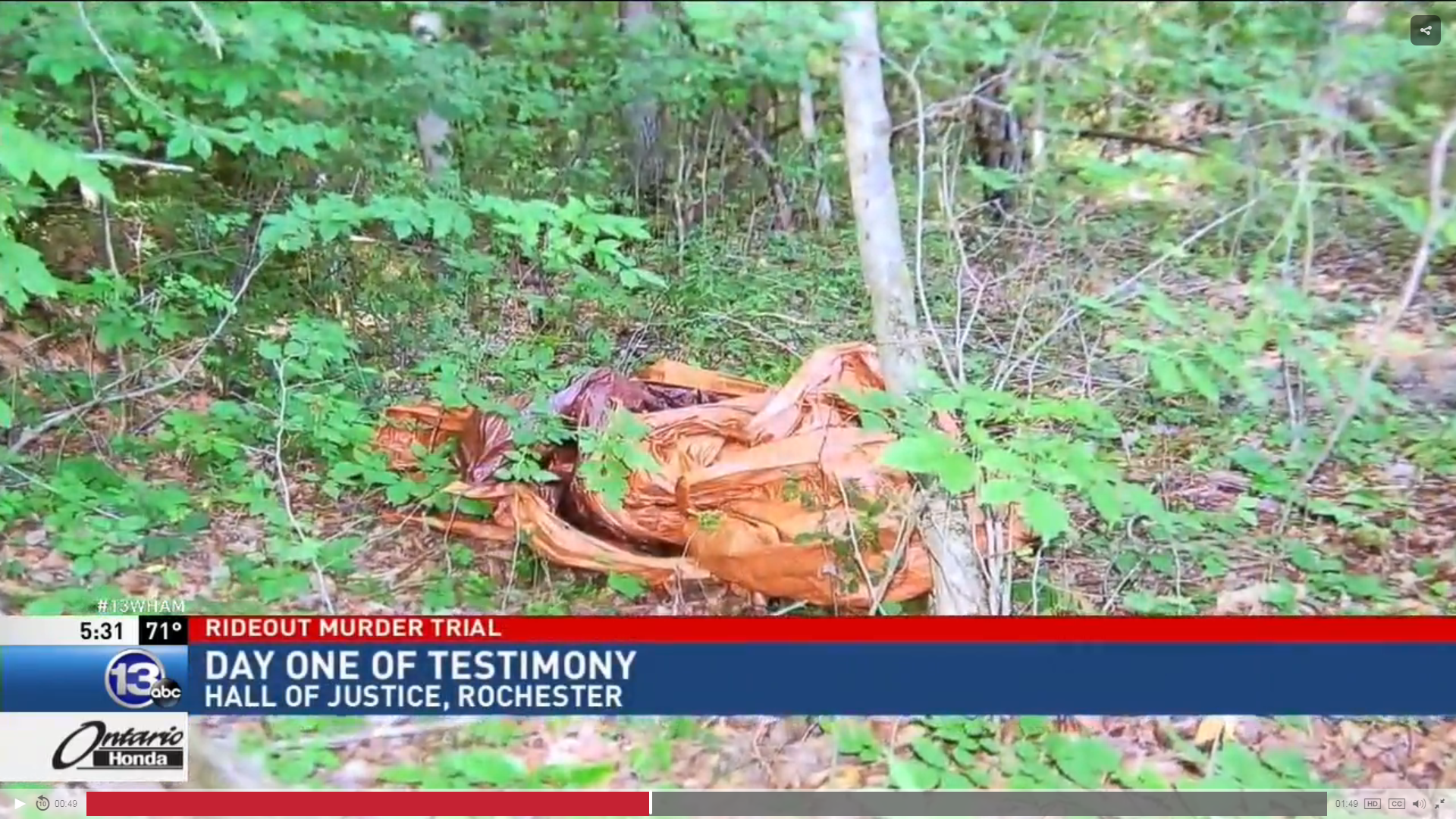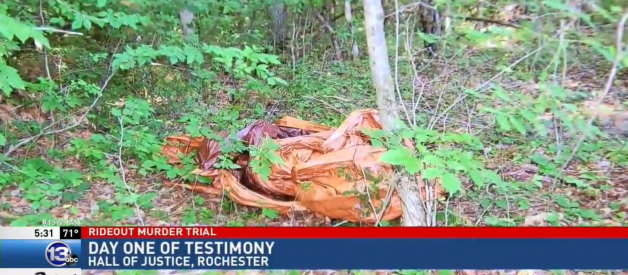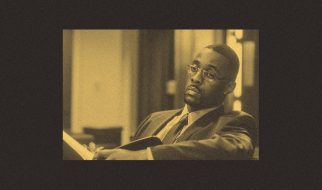If his killers hadn?t bought the wrong shovel, Craig Rideout?s body might still be in the Yates County woods

The Liquid Lightning Drain Opener had done its intended job of obliterating his face and fingerprints, but time and scavengers would also have made him unrecognizable. Rideout, 50, an IT specialist and father of seven from Rochester, NY, could easily have joined the ranks of the missing or unidentified dead within weeks of being dumped off a quiet country road. Instead, he was the victim in one of 2017?s most notorious murder trials.
What almost happened to Craig Rideout illuminates a little-known national issue: A National Institute of Justice report says as many as 40,000 sets of unidentified remains languish in morgues, medical examiner?s offices and anonymous graves around the country; including more than 1,300 in New York State alone.
The region encompassing Rochester, Buffalo and Niagara Falls possesses a profusion of unidentified cold-case victims, including Caledonia Jane Doe, or Cali. Found November 10, 1979, in a cornfield near Caledonia, NY, an adolescent girl shot twice, execution-style. It took 35 years for her to be identified as Tammy Jo Alexander, a teenage runaway from Brooksville, FL. Her murder is unsolved.
According to the National Missing and Unidentified Persons System (NamUS), the recently discovered dead include skeletal remains of a white male buried in a town park in Erie County; the remains of an Asian female in an abandoned property in Greece, NY; bones of a 20- to 30-year-old man found in a garbage bag off the New York State Thruway shortly before Rideout went missing.
New York State?s earliest UID dates back to 1969. The remains of a 45- to 55-year-old white male was located in dense woods off State Route 17 in Tuxedo, around 40 miles northwest of the Bronx. Wearing brown pants, a white T-shirt, a Longine watch, and a gold Saint Christopher medal, he was a son, maybe a father or brother, but like thousands of others, he?s identified only by a six-digit NamUS case number. Without a nickname like Cali?s, he?s unknown even among the unknown.
In October 2017, Rideout?s estranged wife and his eldest son were found guilty of his murder; another son was convicted of tampering with evidence in a botched cover-up of an almost inconceivably brutal and shamefully wanton crime. Many characterized the convicted trio as incompetent AND evil. ?Did they never see an episode of #CSI or #Law&Order? They did everything wrong,? tweeted blogger @Stickit2Stage4 Susan Rahn.
But those familiar with the long-term missing and unidentified know how easily someone can disappear or become separated from his identity after death. ?Five relatively unpredictable, simple things happened,? the forensic expert who identified Rideout?s body tells me. ?Had they not happened, this might have been a long-term missing person case.?
 Photo of Craig Rideout courtesy of the Rideout family
Photo of Craig Rideout courtesy of the Rideout family
Craig Wallace Rideout was born and raised in Pittsford, NY, a Rochester suburb dotted with farms and horse stables, a town whose wholesome, family-oriented events ? outdoor concerts and movies, an annual Halloween fest and Christmas tree-lighting ? make it seem like a throwback to the 1950s.
Craig and his sister, Robbyn, were born 18 months apart. Their father, Dick, a WWII Navy veteran, worked for Eastman Kodak for 34 years. He died of cancer in 2003. His widow, Agnes, known as Nessie, was a travel agent for local execs. Dick and Nessie?s door was always open. One of Robbyn?s childhood friends recalls being treated to roast beef and Yorkshire pudding dinners and French toast on Saturday mornings.
Robbyn and Craig were close as kids, drifted apart in high school and reconnected when Robbyn returned to Rochester after attending college in Vermont. Craig was an economics major at Union College in Schenectady. While not exactly a cut-up ? Craig wrote his senior thesis on ?The Distortionary Effects of Continual Real Government Budget Deficits? and joined an alcohol-free fraternity ? ?he had a wicked sense of humor,? Robbyn said. ?Not mean or naughty, but a little mischievous.?
A few years after Craig graduated in 1988, he met a girl in a Rochester pub. Laura Asam had moved to the area from Syracuse with her parents and four siblings and attended college in Buffalo. Robbyn came across a photo snapped of Laura and Craig when they started dating. ?They were so enamored of each other. You could just see the twinkle in their eyes,? Robbyn said.
Craig and Laura married in January 1993. He was 27 and she was 22. Colin was born that October. The same financial services firm that Craig would work for his entire career hired him as a programmer. In his spare time, he volunteered for a Catholic ministry and youth group and recruited prospective students for Union College. The couple bought a four-bedroom house on six acres in Pittsford. But as more babies arrived, finances became tight.
As much as Craig warned Laura to keep track of the family?s spending, Laura ?never believed that they were in any kind of financial difficulty,? Robbyn said. ?She never took that seriously. She believed that he was hiding money.? Bankruptcy loomed; they were forced to move to a more modest house. Craig?s response to his increasingly troubled home life was to immerse himself in role-playing video games behind closed doors.
An email exchange between Craig and Colin a week before the murder hinted at deeper issues. Colin, in an accusatory but measured tone, listed grievances against his father that ranged from sending away the family cat to what he described as emotional abuse of himself, his mother and his siblings. He related an incident in which his sister and mother locked themselves in his room ?while you tried to force your way in and I held the door shut for hours. This was after you tried to pull me downstairs by the arm and I shook you off.? He referred to ?frantic calls and texts? from two of his sisters while they ?hid in their room from you.? Colin wrote that Craig was ?very careful not to yell at and abuse my mother or siblings? for the past seven years while he or his brother Andrew was around.
Robbyn said later that Craig had at one time sought professional help with parenting. She described him as a ?devoted father? who would not have intentionally hurt or frightened his children.
When Craig responds to Colin?s email in spring 2016, he seems perplexed by his son?s complaints and put out by the fact that Colin cc?d family members ? including Robbyn ? on the accusatory emails. Craig wrote, ?Why don?t you just give me a call, or reach out to me??
Laura?s apparent unhappiness drove a wedge between Craig, his parents, and his sister. On more than one occasion, Laura and some of the kids wouldn?t show for holiday dinners at Robbyn?s or the in-laws. ?We would say, ?Are you guys coming??? Robbyn recalled. ??Yeah, we?ll all be there.? And ultimately maybe four of them would come, and they?d say, ?Oh, mom?s not feeling well.? And then one of the other kids would say, ?That?s not true, mom didn?t want to come.??
Things came to a head in late summer 2014. Laura Rideout filed for divorce and moved in with Paul ?P.J.? Tucci, a longtime family friend whose wife had recently died.
If seeing his wife of more than 20 years become romantically involved with Tucci irked Craig, he barely showed it publicly. Mark Ganchrow, who?d worked with Craig for a decade and jokingly called him his ?work spouse,? recalled Craig as ?unbelievably and unfailingly patient,? calm and good-humored. Robbyn and others paint a picture of a man doggedly determined to keep his chin up despite his world coming apart at the seams. In the email to Colin that precipitated Colin?s heated response, Craig tells him he enjoys talking to him and is ?generally proud to have him as a son.?
Robbyn points out that if Craig was abusive, he would not have been awarded custody of the two youngest of the seven children, then aged 6 and 12. Working full-time, suddenly parenting solo, Craig sought advice from Robbyn, a mother of four. ?We were in considerably more communication after (Laura) left, and I don?t believe she realized that,? Robbyn told me.
For the next two years, Robbyn watched her brother?s relationship with his estranged wife corrode. Once, after Craig complained to his attorney about Laura missing scheduled pickups, showing up unexpectedly, and having Colin drive the younger kids to school and appointments, Laura deposited all the kids on Craig?s doorstep. One of their daughters, in a fury at the situation or at her father, punched holes in the walls of the family home, broke dishes, and shattered light fixtures. Craig?s home computer mysteriously disappeared.
In early summer 2016, things got even uglier.
Laura and Tucci planned to move to North Carolina and wanted to bring the youngest kids with them. Craig objected. After two years at SUNY Maritime College, Colin, then 21, had left school and moved in with Tucci. Seeking employment on Upwork, a website for freelancers, he described himself as ?building my skills in Python and JavaScript, with an eye towards becoming a full-fledged developer?diligent and efficient?an excellent communicator?easy to work with and highly responsive to feedback.?
Intervening with his father on his mother?s behalf precipitated tense interchanges. One night, Craig was awakened by an intruder in his Penfield townhouse who plucked a hair from his arm and stole his house keys and work-issued Blackberry. He called 911 to report the theft, but he suspected the thief was Colin.
By July 19, Laura and Tucci had packed a moving van. Days earlier, they had signed a lease on an apartment in North Carolina.
Robbyn and Craig spoke that night at around 7 pm. Robbyn had seen that Alex, 19, the third oldest son, had posted on Facebook the entire, lengthy, nasty Colin-Craig email exchange from the previous week. ?You are a chronic liar and I?m sick of you dragging my mother through this contorted divorce while you abuse the court system to try and retain control over her life,? Colin wrote, in addition to the allegations of abuse. ?It was a very private, very heated, very personal email that the boys put out there on social media,? Robbyn said. As far as she knew, Colin?s accusations were patently false.
Craig also found the incident shocking and upsetting. He told Robbyn he decided not to respond to the Facebook post. He would raise the matter in a slightly less public setting: the next custody hearing. He thanked Robbyn for her help and support. Before they hung up, Robbyn said she?d check in with him the next day.
The following morning, Robbyn emailed Craig from the Pittsford insurance agency where she works as an account manager. Craig didn?t respond. He didn?t answer his work phone or return her call to his cell phone. This was unusual. If he?d been in a meeting when she called, he would have texted her. She called his workplace. They read her an email they?d received from him the previous night: ?My daughter remains ill. I may not be able to answer the phone as I will probably be taking her to the doctor?s office.?
Robbyn didn?t think that sounded like her brother. He?d say the 6-year-old girl was puking, not ?remains ill.? At her lunch hour, worried and perplexed, she drove to his townhouse. Through sliding glass patio doors, a figure waved. Robbyn was relieved until she realized it wasn?t Craig, but Laura.
At the trial, Robbyn wore somber dresses, blazers and tortoiseshell glasses, her blunt-cut blonde hair falling just below her ears, a tiny gold cross on a chain around her neck. She exuded focus and determination; in unguarded moments, her face crumpled. In contrast, Laura, sharp-featured, with a swath of dark shoulder-length hair skimming her arched eyebrows, sat stony-faced, fidgeting with something in her lap.
More than two and a half years later, the dread Robbyn felt at the moment she saw Laura in Craig?s kitchen still makes her heart pound. Inside the townhouse, her sister-in-law appeared to be wiping down a counter. Robbyn had never known Laura to be a neat freak. The custody order stipulated she was not supposed to be in Craig?s home.
When Robbyn joined Laura in the kitchen, Laura told her, ??I knew it wouldn?t be long before someone came looking for him. I don?t know where he is.?? Laura pulled out her phone and showed Robbyn texts Laura said were from her son Patrick, asking to be picked up. The messages looked like they came from Alex, but Laura said that it was because the 12-year-old was using Alex?s old phone. She told her sister-in-law that Colin had just picked up Patrick and their younger sister but she, Laura, stayed to clean up because the kitchen smelled. In a barely contained panic, Robbyn tried to act as if Laura?s words and behavior made sense.
The two women left together. Laura seemed rattled. She carried a trash bag. Even though she?d apparently driven there alone, Robbyn watched her climb into the passenger seat of a burgundy Ford parked in the space usually occupied by Craig?s Honda Odyssey minivan. Laura moved to the driver?s seat and drove off.
Inside the house, when Robbyn had quickly searched for Craig, she had spotted all three pairs of his shoes lined up neatly near the front staircase. Back at her office, Robbyn told her boss what she?d seen; he suggested she contact Craig?s divorce lawyer.
?Call 911,? the attorney told her. ?Tell them Craig is missing.?
Dr. Randolph L. Mitchell is a dentist in Lyons, New York, a small town midway between Lake Ontario and the Finger Lakes. Inspired by CSI and then 9/11, Mitchell decided to train in forensics. When the need arises, he drives an hour to the Monroe County Office of the Medical Examiner in Brighton, NY, to identify the deceased through dental records.
Mitchell was on call for the medical examiner on July 20. At his family camp on Cross Lake, he saw news reports about a missing Rochester man. A couple of years earlier, Mitchell had helped identify a body found in Lake Ontario that turned out to be a 53-year-old jewelry store owner from Kenmore, NY, who had somehow slipped or fallen into the Lower Niagara river. After 192 days as a John Doe, the man?s identity was confirmed and his body turned over to his family.
Family members of the long-term missing have told me that some jurisdictions ? erroneously ? required them to wait 24 to 48 hours before filing a report on their loved ones. Others were told to go home and wait; many missing persons return on their own accord. And if they don?t? Well, there?s no law against an adult going missing.
Robbyn believes Monroe County took her missing-person call seriously because they knew something she didn?t.
That morning, around 50 miles south of Rideout?s townhouse, a Mennonite farmer was bicycling to work before dawn on a quiet, two-lane country road flanked by fields and woods. Yates County, population 25,000, is largely farmland. The farmer noticed two cars parked near the intersection of Yatesville Road. Two figures stood nearby. Riding back three hours later, the farmer spotted a shovel by the roadside. Following a trail of trampled grass into the woods, he saw a brown tarp, a bare human foot visible underneath.
Yates County sheriff?s deputies accompanied the farmer back to his gruesome find. As the deputies stood by, a cell phone began to ring. The sound seemed to be coming from under the tarp.
Back at the townhouse, Robbyn wanted sheriff?s deputies to force open Craig?s locked bedroom door, but they declined; they needed a warrant. At 5 pm, a victim advocate called Robbyn. She told her her brother may have been the ?victim of a violent crime.?
Later that evening, Laura Rideout and Paul Tucci showed up at Craig?s townhouse with the two youngest Rideout children in tow. Dave Bolton, a Monroe County investigator, was at the scene. They told him they were dropping the children off as dictated by the custody arrangement. Laura admitted she?d been at the house earlier that day. She?d tidied up, she said, and put a box of books on a piano in the basement. Laura and Tucci claimed they did not know where Craig Rideout was.
In Yates County, the sheriff?s department was pretty sure whose disfigured body they had found. Robbyn Drew?s name had lit up the screen of the phone in the dead man?s pocket. When the Blackberry was stolen, Robbyn had bought her brother a prepaid smartphone ? a fact Craig apparently had not mentioned to his soon-to-be-ex.
Two days later, Randy Mitchell examined the body. Photos of a living Craig show a clean-shaven man with a wide-open grin, wire-rimmed glasses, a high forehead, and strong jaw. The body on Mitchell?s table had blurred, melted features and upper chest darkened to the shade and consistency of old shoe leather. The deceased?s right cheekbone was fractured and a blood vessel in his neck torn open. Mitchell compared the teeth to dental X-rays ? a clear match with the set obtained from Rideout?s dentist. Mitchell could have made the ID based on distinctive fillings alone.
 Photo of Craig Rideout courtesy of the Rideout family
Photo of Craig Rideout courtesy of the Rideout family
Investigator Bolton later pieced together that the night of July 19 and early morning of July 20 went something like this: Laura and Colin bring the two youngest children to Craig?s townhouse. After the children are in bed, Colin lures Craig to a cement-walled storage area in the basement stacked with U-Haul boxes. There, someone ? the prosecution did not say who ? struck him in the face with a hammer or an iron and tightened a homemade ligature fashioned from duct tape and paracord around his throat, breaking the small bones in the muscles of his neck and ripping a hole in his flesh.
Later, investigators found blood on a plastic tote box and on wood shelving. In garbage bags, they found the garrotte, cleaning agents, bloody gloves and clothing.
Bolton told reporters that the killers probably didn?t expect a struggle. ?His killers may have anticipated that the murder would be quick and tidy,? Mitchell agreed. ?Instead, they ruptured his carotid artery, causing an enormous blood loss.
?The family probably didn?t expect to have to spend the crucial time to clean up a big mess and leave visible blood evidence at the scene and on their clothes,? he said. ?They likely thought they would be in, out, and gone in minutes.?
Cell tower pings traced the phone in Rideout?s pocket from the Penfield townhouse around 3 am to the Yates County roadside where the farmer found the body. Surveillance video from businesses along the 50-mile route showed a pair of vehicles ? Craig Rideout?s minivan and a car belonging to Paul Tucci ? on their way to and from the scene where the body was dumped.
The day after Robbyn encountered Laura at Craig?s townhouse, the police got a call from a Pittsford resident who?d seen two young men tossing black garbage bags into a local pond called Devil?s Bathtub. Colin and Alexander Rideout were found with bags of empty bottles of drain cleaner, gloves, bloody clothing, and paracord like that used in the garrotte. Quizzed by investigators at the park, Colin said his mother asked him to get rid of the bags. Alex said something about his father leaving town. DNA later tied the blood and clothing to Colin, Alexander, Laura Rideout, and Tucci.
Over five weeks in 2017, prosecutors introduced 700 pieces of evidence at the New York State Supreme Court trial of Laura, Colin and Alexander Rideout and Paul Tucci. A surveillance video showed Laura in jeans and Tucci in a faded red T-shirt walking the aisles of a local Walmart. Laura grabs a shopping cart and they pile it with brown bottles. (?Fast acting!? says the label of Liquid Lightning Drain Opener.) At the register, Tucci hands over cash. Laura loads bags back into the cart. Jurors saw footage of Colin leaving a different Walmart with a square-edged shovel identical to the one the farmer spotted by the roadside. Investigators found a groove in the dirt, apparently an aborted attempt to dig a grave. A pointed tip would have been more effective in the dense, rocky soil, Mitchell said. ?The ground was not turnable with that kind of a shovel,? he said. Colin ?was inexperienced at digging in the woods, maybe.?
On July 25, 2017, the jury convicted Laura and Colin Rideout of second-degree murder and Alex Rideout of tampering with evidence. Tucci ? to the surprise of many observers ? was acquitted.
Three months later, when Alex Rideout, 20, was sentenced to two to eight years and Laura, 46, and Colin, 24, received the maximum sentence of 25 years to life, justice Thomas Moran said, ?This case was premeditated, it was evil, and it was diabolical.? Monroe County Sheriff Patrick O?Flynn called it ?one of the most heinous crimes? he?d encountered in 30 years in law enforcement.
Bolton told a local TV reporter that despite the verdict, he?s convinced Tucci was a key player. Aside from the murder itself ? Bolton believes Tucci struck Rideout in the face with an unidentified metal object ? Tucci would have been needed to help carry a six-foot, 200-pound body up from the basement, stow it in the minivan, drive it to Yates County and dump it.
In August 2019, I received an email from Paul Tucci. The subject line was blank. This is the unedited content: ?Frankly I have never seen a more one sided reporting on a topic ever. Robyn rideout is the least credible resource as she was not only uninvolved in the Rideout affairs for twenty years, she had the most to gain from his death. She is now the SOLE heir to the rideout Estate, and also the insurance agent for the Rideout clan. Your failure to even research any other aspect makes you complicit in the whole sham? I know the truth, and your piece is pure fiction, and frankly I know more than the two of you combined.?
The Court of Appeals, the state?s highest court, in May 2020 declined to hear Laura Rideout?s appeal. Earlier, her appeals had been denied by a regional appellate court. In early 2019, I wrote to Laura Rideout at Bedford Hills Correctional Facility for Women in Westchester County, where the earliest she can now be considered for parole is in 2056, giving her an opportunity to offer something ? an apology? ? to the family and others who cannot fathom her thinking or her actions.
In response to Tucci, I wrote, ?If you are aware of inaccuracies, please let me know how I can set the record straight.? I never heard from him again, or from Laura Rideout.
If not for a series of unforeseen events ? the lengthy cleanup, the predawn sighting by the Mennonite farmer, Robbyn?s unexpected visit to the townhouse, the secret cell phone, a tip that two young men were acting suspiciously at Devil?s Bathtub ? Mitchell believes the aftermath of Craig Rideout?s murder would have played out differently. At forensic conferences, he lectures to packed auditoriums about the Rideout murder. ?It is my OJ Simpson case,? he emails me in early 2019. ?I?ll never see anything that even comes close to it. It was almost the perfect crime.?
As horrific as her brother?s fate was, Robbyn Drew knows it would have been worse if his body had not been found for weeks, or not found at all. If July 20, 2016, had come and gone as the killers intended, Rideout?s minivan would be where they left it, at a bus station park-and-ride en route to the New York Thruway. Calls to Rideout?s Blackberry would have gone unanswered. Laura and Paul Tucci would have driven south in a moving van.
The day after Craig was reported missing, Alex Rideout told investigators he was worried about his father?s state of mind. Craig had threatened to disappear, Alex said. ?I figured he was on the next flight to Mexico.? Robbyn, still incredulous more than two years later, told me, ?They wanted to make it look as though he walked away.? Some might have believed he had. Craig Rideout would have become one of the thousands of adults who vanish every day in America.
Weeks, months or years later, Yates County John Doe would be entered into NamUS.


